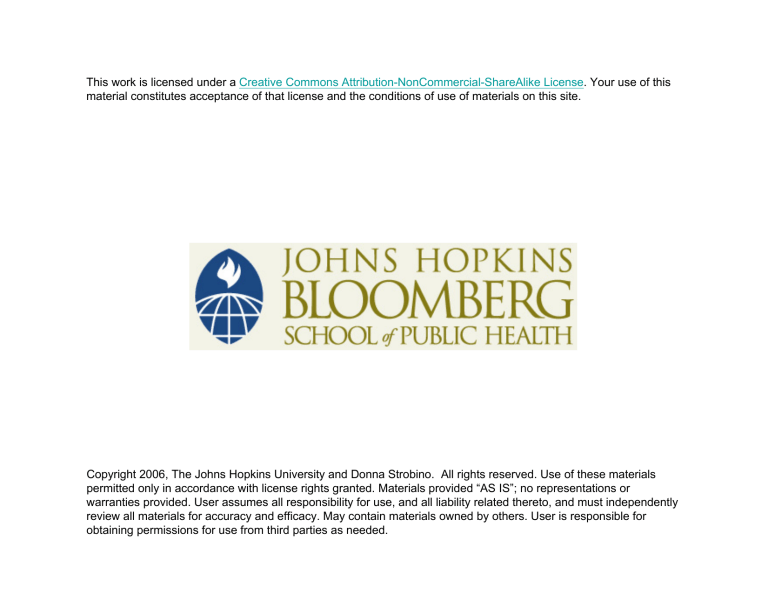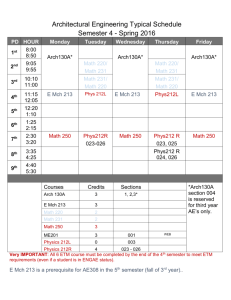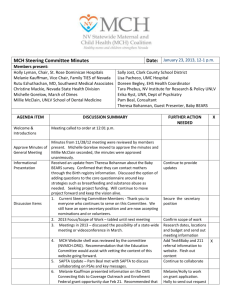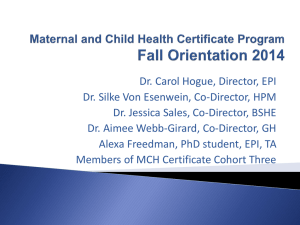
This work is licensed under a Creative Commons Attribution-NonCommercial-ShareAlike License. Your use of this
material constitutes acceptance of that license and the conditions of use of materials on this site.
Copyright 2006, The Johns Hopkins University and Donna Strobino. All rights reserved. Use of these materials
permitted only in accordance with license rights granted. Materials provided “AS IS”; no representations or
warranties provided. User assumes all responsibility for use, and all liability related thereto, and must independently
review all materials for accuracy and efficacy. May contain materials owned by others. User is responsible for
obtaining permissions for use from third parties as needed.
MCH Needs Assessment :
An Overview
Donna Strobino, PhD
Public Health: MCH Example
Focus is on the POPULATION
Emphasis is on PREVENTION
Orientation is toward the COMMUNITY
Efforts are directed at SYSTEMS
Overarching role is one of LEADERSHIP
Overview
Needs Assessment as Applied to
Maternal and Child Health
Frame of Reference, Title V State
Programs in the United States
Analytic and Political Process
Assessment to Assurance to
Monitoring
Public Health Assessment
As public health programs, public
health programs engage in the core
functions of public health, as applied
to promote the health of populations:
– Assessment
– Policy development
– Assurance
– Organized as 10 essential MCH
services
MCH Assessment
Long History: 1912 charter establishing
the Children’s Bureau
State Title V agencies must conduct
comprehensive needs assessments every
5 years, to identify and monitor MCH
priorities and performance measures
MCH assessments are to be populationbased and community-focused
Needs Assessment
Needs Assessment is:
– essential to identify the most appropriate
programs and policies to promote the
health of women, children, adolescents,
and their families
– a fundamental element of any program
planning activity
– about change
Needs Assessment
Needs Assessments are data-driven
BUT, in recognition of the politics of
policy-making, program development
and resource allocation in public
health, needs assessments must also
engage and involve the community of
interest, the stakeholders
Needs Assessment
Needs Assessments try to bridge:
The science and the politics
The data and the values of the
community
The needs and the strategies for their
solution
All within a comprehensive planning
process
MCH Needs Assessment
Needs assessment is an ongoing
process
The 5 year MCH assessment should
be a point at which the process is
revisited and formalized for current
and future planning
This 5 year assessment should also
suggest focused assessment
activities in the intervening years
Needs Assessment
Parameters of needs assessments can
vary
Statewide or in specific communities?
Entire population or particular
population groups?
All of MCH or just certain aspects?
Any health issue or focused topics?
Independent or in collaboration with
other groups?
Involving Stakeholders
Essential to the entire needs
assessment process that we involve
and engage stakeholders early on and
throughout the process
What we do in public health is
ultimately about the public, it needs
public buy in that a problem exists or
about our solution to the problem
Involving Stakeholders
For MCH they typically include:
– Other state agencies, including
sister programs within the MCH
state agency
– Local health departments and other
local government agencies
– Providers and facilities serving MCH
populations
– Professional organizations
Involving Stakeholders
For MCH they typically include:
– Community-based and advocacy
organizations
– Funders and/or elected officials
– Clients of service programs
– The media
– The public at large
Involving Stakeholders
Stakeholders can help to:
Identify the full scope of needs
Interpret available data or collect new
Sort out priorities
Identify and select solutions
Build consensus
Advocate for needed changes
Support overall efforts
Sources of Data
Four major data sources:
– Population-based data (vital records,
census)
– Surveillance systems and survey data
– Program or service data
– Public forums or focus groups
Direct public, media and political sources
(anecdotal)
Resource inventories or other processes
for assessing capacity
Sources of Data
Population-based Data
Census
Vital Records
– Births
– Deaths
– Fetal Deaths
Sources of Data
Surveillance Systems & Survey
Data:
Ongoing targeted state surveys:
SLAITS, BRFSS, YRBS,
PRAMS
Communicable disease and
registry data
Special Surveys
Sources of Data
Program and Service Data
– MCH direct services data
– MCH-related contracted services data
– Data from other sister programs &
agencies that extend to a larger
population
Sources of Data
Program and Service Data
– Children with Special Health Care
Needs
– Newborn Screening
– WIC
– Family Planning
– School-based Clinics
– Prenatal Clinics
– Immunization Programs
Sources of Data
Program and Service Data
– Medicaid
– Education (special ed, lunch & breakfast
programs, graduation rates)
– Social Services (child abuse adoption,
foster care, child care)
– Mental Health and Substance Abuse
– Justice (adult and juvenile)
Sources of Data
Public Forums and Focus Groups
Town Meetings and Public Forums
Focus Groups
Anecdotal Data
– Concerned citizens
– Media reports
– Elected officials
Sources of Data
Resource Inventories: assess
capacity:
– Identify services available from variety
of providers
– Reveal gaps in services (elements,
geography, accessibility, continuity)
– Identify under-utilized capacity (missed
opportunities)
– Optimize capacity given needs identified
Sources of Data
Resource inventories do not
Indicate need
Evaluate quality
Assess effectiveness of services
within the larger system
Sources of Data
State Level: resource inventories
assess about overall capacity
– State-level programs in operation
– Eligibility for the programs
Local Level: inventories more
specific
– Within communities, specific services
available
– Type and nature, hours, accessibility
Needs as Values
From various data sources many
patterns, issues, & needs emerge
How do we sort them out?
Typically look for some level of
discrepancy between a desired & the
actual state
Remember, needs are expressions of
what we value; needs are values
Needs as Values
Needs: value judgments that suggest
problems for specific population
groups or in specific communities
Needs, as reflections of values, are
subject to disagreement and debate
For needs to be useful in policy and
program planning there has to be
agreement that they reflect real and
important problems
Setting Priorities
Segmenting the needs into natural
categories:
– Women & infants; Children, children &
adolescents; Children with special
needs
– Rural, urban & frontier
– Cultural or ethnic groups
– Primary, secondary & tertiary
prevention
Setting Priorities
Criteria for selection of priorities
Primarily concerned with size and the
seriousness of the problem
– Size: extent of the problem, numbers
affected directly, numbers affected
indirectly
– Seriousness: urgency, severity,
economic loss, potential impact on the
population (SARS) or on family groups
(homicide)
Setting Priorities:
Availability of interventions
Effectiveness of interventions
Economic feasibility
Community perception of the
problem
Political issues related to the
problem
Selecting Solutions
Not enough to identify something as a
problem or a high priority need
We MUST determine whether we can
do anything about the need and what
precisely it is we can and wish to do
Only then can a need achieve State
Priority status
Selecting Solutions
To avoid the narrow vision of that
which we already know, we can
look to other core functions to help
us think more broadly:
Essential MCH services
Selecting Solutions
Needs will be identified that are not
within your purview
The fact that you know about them
places responsibility on you to at least
alert someone else to the problem
Leading in policy development
includes informing responsible parties
& advocating for appropriate &
necessary levels of change
Selecting Solutions
Public Health ASSURES by:
– Directly providing services through local offices
or state health department clinics
– Contracting with other entities to provide direct
services
– Regulating services provided by others or
regulating problem or promoting quality
improvement
– Educating professionals, providers or the public
– Collaborating with others in systems
development efforts
– Gathering data to inform efforts in key areas
Priority Need Identified: Childhood Obesity
MCH Essential
Services
Consider the Possibilities . . .
Provide
Population screening; nutrition counseling; weight
services directly management programs; community fitness programs
Contract with
others
Negotiate a contract to Weight Watchers to develop
and provide weight management programs to children
Regulate the
activity
Ban vending machines in schools; require nutrition
labeling of all fast food products; restrict advertising;
require green spaces in communities of certain size
Educate public,
providers, etc
Develop media campaigns on the importance of
nutrition and physical fitness; educate providers to
screen all children and counsel parents
Systems
development
Convene schools, health providers, media, food
establishments, health clubs, sports orgn’s to devise
solutions
Data
improvements
Develop population-based data system to monitor &
track weight status on children, dietary intake, fitness
Critical Phases in Needs Assessment
Start-up Planning
Operational Planning
Data Gathering
Needs Analysis
Capacity Assessment
Program and Policy Development
Resource Allocation
Performance Measurement
Evaluation
Petersen, DJ and GR Alexander. Needs Assessment in Public Health: A Practical
Guide for Students and Professionals. 2001, Kluwer Academic/Plenum
Publishers, New York.
Needs Assessment
Needs Assessment is a critical element
of what we do as leaders in Public
Health
Good needs assessments:
inform our decision-making processes
engage our partners and constituents
help foster accountability
support and confirm our systems
development and leadership roles






